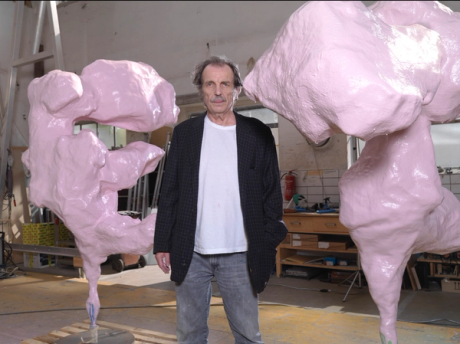UFO-Expedition (U.F.O.)
1982 - Drawing & Print (Drawing & Print)
29,2 x 21 cm
Julius Koller
Wordplay was a central focus of Koller’s work, in particular the acronym U. F. O., which he adapted in his diagrammatic drawings to stand variously for Univerzálna Futurologická Organizácia (Universal Futurological Organization, 1972–3), Univerzálny Filozoficky Ornament (Universal Philosophical Ornament, 1978) or Underground Fantastic Organization (1975), and which also appeared in a series of slapsticky self-portraits titled ‘U. F. O.–naut’ (1970–2007). These infinite variations on a common cipher constituted an insistent incantation of the Utopian principle. Friedrich Nietzsche argued that to realize a fundamental critique of ‘bad faith’ means to move beyond cynicism and embrace a radical optimism that exceeds the petty dialectics of expectation and disappointment. In his approach to life and art as the U. F. O.–naut, Koller embodied precisely this: he actualized the potential of his imagination as a form of existential agency. As we get entangled in the strange possibilities of art and ideas, we all become U. F. O.–nauts and are deeply indebted to Koller, our patron saint of U. F. O.–nauts.
In its stringency, obsession and peculiarity, the oeuvre of Julius Koller is one of the most idiosyncratic and consistent in European art since the 1960s. Yet Koller is not only a seminal figure in the history of the neo- and post-avant-garde; his work has long been a critical inspiration for artists and intellectuals. In the most recent past, Koller’s concepts of the Anti-Happening, the Anti-Picture, the Universal-cultural Futurological Operation (U.F.O.), his actions, objects, texts and the enormous referential archive he built up, have attracted growing interest on the part of a broader art public. From around 1960, in response to the modernist mainstream in Slovak art, Julius Koller began to develop his aesthetic position of the “antihappening.” His strategy consists in using real objects and everyday life as the predefined program for an aesthetic operation: from 1965, in texts rubberstamped on paper that refer to the context of the “anti-happening,” and then in 1967/1968 in pictures for which Koller used white latex paint instead of oils and which saw the first appearance of the question mark—the symbol of Koller’s brands of naming, or “making known,” that was later to undergo many mutations in various media and states of aggregation. The “invitation cards for an idea”—as Koller called the text works relating to the “anti-happenings”—and the palimpsests and serial arrangements of the “anti-pictures” set themselves apart from the academicism of Modernism in more than just formal terms. Koller foregoes every form of technical mastery. The “anti-pictures” are amateurish in style, ensuring that they fulfill their task, defined by Koller as “engaging rather than arranging.” Julius Koller was born in 1939 in Piestany, Slovakia. He died in 2007 in Bratislava.
Colors:
Related works sharing similar palette

© » KADIST
Sheroanawe Hakihiiwe
2019Wateoma husipe / Larvas de oruga / Caterpillar larvae by Sheroanawe Hakihiiwe exemplify his most abstract work, where he choses particular elements of a living organism to create his renditions...

© » ARTS EQUATOR
SDEA Theatre Arts Conference Keynote Interviews: Drama lessons in a pandemic (Part 1) | ArtsEquator Thinking and Talking about Arts and Culture in Southeast Asia ArtsEquator Viewpoints May 2, 2021 By Sarah Tang SDEA is holding its first fully online Theatre Arts Conference this year from 22 to 30 May...

© » KADIST
Colter Jacobsen
2010The title Untitled Passport II was first used by Felix Gonzalez-Torres in an unlimited edition of small booklets, each containing sequenced photographs of a soaring bird against an open sky...

© » KADIST
Power Forward Wednesday, January 24, 2018 Bar 6pm, Program 7pm Ezekiel Kweku & Ameer Lo ggins in conversation, moderated by Sarah Hotchkiss Editors Astria Suparak & Brett Kashmere in person To celebrate the launch of Sports , the newest issue of artist-run publication INCITE: Journal of Experimental Media , KADIST hosts an evening of athletics, politics, art, and dialogue...

© » KADIST
Gan Chin Lee
2019In Studies of Chinese New Villages II Gan Chin Lee’s realism appears in the format of a fieldwork notebook; capturing present-day surroundings while unpacking their historical memory...

© » KADIST
Maria Fernanda Plata
2015Unraveling, or “unweaving” sections of fabric, Maria Fernanda Plata arrived at delicate and tenuous-looking forms, both ghostly and gentle...

© » LENS CULTURE
Cultural Changes at the Coldest Place on Earth — A Photo Story from Yakutsk - Photographs by Alex Vasyliev | Essay by Marigold Warner | LensCulture Feature Cultural Changes at the Coldest Place on Earth — A Photo Story from Yakutsk Photographer Alexey Vasyliev offers an intimate look into the life and changing culture of the Evens, an indigenous tribe in his hometown of Yakutsk — one of the coldest places on Earth...

© » DAZED DIGITAL
Another Man is relaunching for a new era of men’s fashion | Dazed â¬…ï¸ Left Arrow *ï¸âƒ£ Asterisk â Star Option Sliders âœ‰ï¸ Mail Exit Fashion News The cult menswear magazine will return next spring, with editor-in-chief Ellie Grace Cumming at the helm 12 December 2023 Text Dazed Digital AnOther Man Starring Robert Pattinson 6 Another Man is officially back...

© » KADIST
Milena Bonilla
2009Milena Bonilla’s discursive practice explores connections among economics, territory, and politics through everyday interventions...

© » KADIST
Sin Wai Kin
2017A woman you thought you knew by Sin Wai Kin originates from a performance series titled A View from Elsewhere ...

© » HYPERALLERGIC
National Academy of Design Presents “Sites of Impermanence” Skip to content Willie Cole, “Five Beauties Rising” (2012), suite of five prints, intaglio and relief (courtesy the artist) The National Academy of Design’s new exhibition , Sites of Impermanence , celebrates the contributions of the 2023 Class of National Academicians: Alice Adams, Sanford Biggers, Willie Cole, Torkwase Dyson, Richard Gluckman, Carlos Jiménez, Mel Kendrick, and Sarah Oppenheimer...

© » KADIST
Oren Pinhassi
2020Oren Pinhassi’s work examines the relationship between the human figure and the built environment...

© » THEARTNEWSPER
Supreme court ruling concludes lengthy battle over Franz West estate Art market Museums & heritage Exhibitions Books Podcasts Columns Technology Adventures with Van Gogh Search Search Artist estates news Supreme court ruling concludes lengthy battle over Franz West estate The Austrian sculptor's art will go to his private foundation, represented by Gagosian, overturning previous decision granting ownership to West's widow and children Anny Shaw 18 December 2023 Share Franz West in his studio, 2009 © roessle A long-running inheritance row over the estate of Franz West, reportedly worth more than $50m, has finally been resolved after the Austrian supreme court last month concluded that all of the Austrian sculptor’s art should be donated to the Franz West Private Foundation, which is represented by Gagosian...

© » LE MONDE
Sélection galerie : Farnood Esbati chez Christian Berst Cet article vous est offert Pour lire gratuitement cet article réservé aux abonnés, connectez-vous Se connecter Vous n'êtes pas inscrit sur Le Monde ? Inscrivez-vous gratuitement Article réservé aux abonnés Sans titre (vers 2020), de Farnood Esbati...






